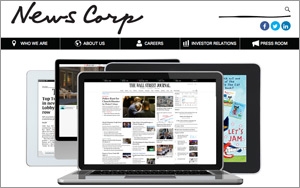News Corp. Revenues Sink On Print Ad Declines
- by Erik Sass @eriksass1, November 10, 2015
 2015 has been no kinder to the newspaper industry than previous years, judging from the latest results from some of the world’s biggest newspaper publishers.
2015 has been no kinder to the newspaper industry than previous years, judging from the latest results from some of the world’s biggest newspaper publishers.
In the most recent round of less-than-stellar news, News Corp. announced that total revenues slid 4% from $2.11 billion in the third quarter of 2014 to $2.04 billion in the third quarter of 2015. That was due principally to the continuing decline in print advertising, as well as currency fluctuations at its newspaper division.
Total revenues at News Corp.’s newspaper division fell 11% from $1.45 billion to $1.29 billion, as ad revenues tumbled 13% and subscription and circulation revenues slipped 6%.
When foreign currency fluctuations are excluded, including the weakening Australian dollar, total revenues were down 3%, with ad revenues down 5% and subscription and circulation revenues down 2%.
advertisement
advertisement
However, there was a bright spot in News Corp.’s U.S. operations, as the company reported that print and digital ad revenues both increased at Dow Jones, publisher of The Wall Street Journal.
Revenues at News Corp.’s cable network programming division also fell 11% from $139 million to $124 million over this period, due principally to foreign currency fluctuations, reflecting its heavy exposure to the Australian market; when these are excluded, revenues who have increased 10%.
These declines were partially offset by a small increase at News Corp.’s book publishing division, up 1% to $409 million, and a big jump at its digital real estate services division, up 71% to $191 million following the acquisition of realtor.com.
News Corp. CEO Robert Thomson noted that for all the troubles the publishing industry has experienced, it stands to benefit from increase advertiser scrutiny of online channels, which should fuel a flight to reputable media providers: “In the areas of data and advertisinf, we believe markets are on the cusp of significant upheaval. Contemporary advertising has been distorted by trash traffic, invisible impressions and mockable metrics to the detriment of advertisers, large and small. Respected brands and quality journalism will have a particularly profound value at a time when so many so-called audiences are artificial.”


